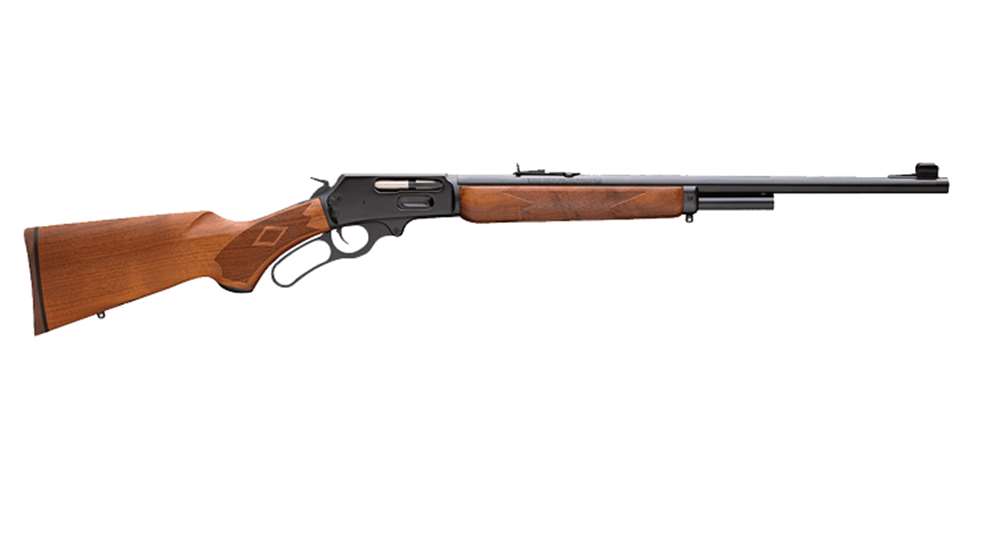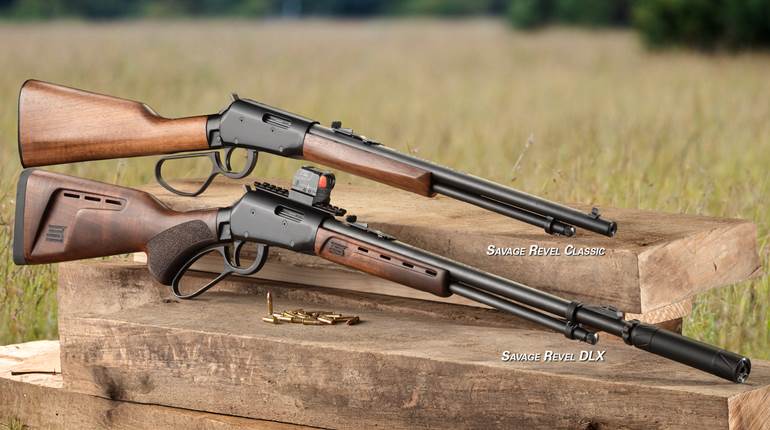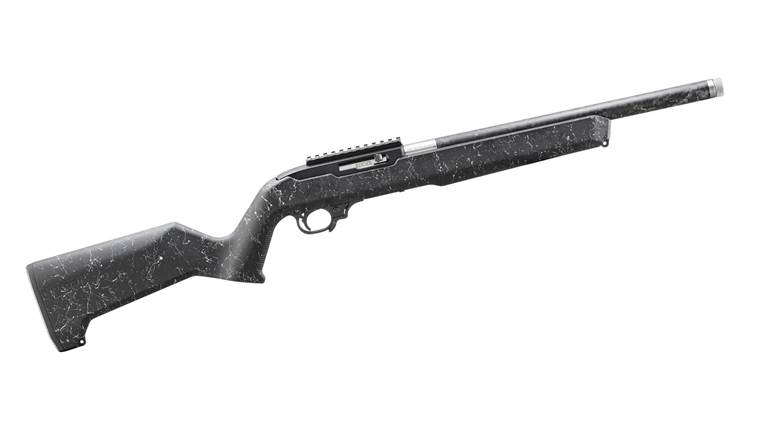
This firearm has the rare distinction of being two separate and different rifles with the same model number. The first Marlin Model 1895 debuted in 1895 and was virtually identical to the company’s 1893 model, except the newer model was scaled up to better handle larger cartridges. The 1893 model was brought about by Lewis Lobdon (L.L.) Hepburn as an improvement over his Model 1889 rifle.
Hepburn was employed by Marlin after his previous employer, Remington, was forced into receivership. He brought with him an excellent reputation both as a competitive marksman and a rifle designer. Hepburn secured some 20 patents during his 30-year career at Marlin.
The Model 1895 was chambered in a variety of large-bore black powder cartridges of the day, including the .38-56, .40-65, .40-82 and the .45-70. Later it would also be chambered in .45-90 and .33 Winchester Center Fire (WCF) cartridges. It originally featured a color casehardened receiver, though a blue receiver was available at no extra cost. With a 26" barrel, the overall length of the Model 1895 was 35 1/2". A carbine version with a 22" barrel was available, and in 1897 a 15" barreled model was offered. These featured a saddle ring—Marlin called it a sling ring—on the left side of the receiver. Carbine versions of this early 1895 are very rare. A major distinction of the Marlin rifle over the Winchester was its square-like bolt and side ejection and solid-top receiver. The top tang of the Model 1895 was drilled and tapped for a peep sight. In 1903 Marlin began drilling and tapping the top of the receiver for its Hepburn Receiver Sight. Along in 1912, Marlin produced a lightweight Model 1895 with a thinner barrel chambered in .33 WCF.
For whatever reason, the Model 1895 never really caught on. Just 18,000 rifles were made during its 22-year run. Perhaps the introduction of bolt-action rifles and their high-velocity bottlenecked cartridges overshadowed the Marlin lever-gun. Nonetheless, the Model 1895 was a solidly built and accurate rifle.
Fast forward to the year 1936. Like everyone else, Marlin was struggling to survive The Depression. It brought out a Model 1936 rifle that retained solid-top, side-ejection features debuted by Marlin 53 years earlier. The Model 36—as it became known—retained the square-like bolt of the Model 1889 and 1893 models. However, this set up was expensive to make with several costly machining operations needed to make the rifle. This, of course, was long before the modern machining centers we have today that are computer controlled. At that time, each part had to be moved from one milling operation to the next, taking a lot more time and, thusly, more costly. The Model 36 had a 12-year run and was redesigned into the Model 336 in 1948.
Improvements in the Model 336 include a bolt made from round stock, an improved extractor made from spring steel, a window in the right side of the receiver for ejection and single-cartridge loading and a corresponding round hole in the rear of the receiver to accommodate bolt travel. This left a large piece of the receiver metal at the rear intact, strengthening the receiver, as well as adding a bit of streamlining to it. The Model 336 is an unqualified success, with more than 5 million copies made. It is still with us today.
Marlin believed—correctly—that there were plenty of hunters who still bought into the big-bore-is-better concept. Many woods hunters especially found that high-velocity, scope-sighted rifles were more of a hassle than an asset in their hunting grounds. So in 1972 it sort of reintroduced the Model 1895 rifle. This time, however, the big rifle was based entirely within the Model 336 family of receivers. This newer Model 1895 came with a 22" barrel, a four-shot half-magazine, a straight stock with a slightly curved hard rubber buttplate and Marlin’s squared finger lever. Sights were a folding Rocky Mountain buckhorn rear and a gold-bead post front. The receiver was drilled and tapped for scope mounting, and the top was bead blasted to reduce glare. At 40 1/2" in length and 7 lbs. the Model 1895 was and remains the woods hunter’s dream gun.
While it didn’t necessarily set the world afire with sales records, the new Model 1895 enjoyed a brisk acceptance. Cartridges that originated in U.S. military arms have always enjoyed a great deal of popularity. Even today, the 112-year-old .30-06 is among the top chamberings for hunting rifles. The even older .45-70 retains a somewhat smaller but equally devoted following. Like its little brother, the .45 ACP, things that get hit in the right place with a .45-70 are usually down for the count. However, sales began to level off, and in 1980 Marlin offered a Sporter version of the 1895.
The Sporter, deemed the Model 1895S, has a pistol grip stock with a cap set off by a white-line spacer and a flat, hard-rubber buttplate, also with the white-line spacer. Along with the curved grip, the lever was changed to a round configuration. The front sight was changed to a ramp type with a Wide-Scan hood. Quick-detachable swivels and a sling were added to finish out the rifle.
In 1984 Marlin added a cross-bolt safety to all of its lever-action rifles. This changed the nomenclature of the 1895 Sporter to the Model 1895SS.
Big-bore lever actions are enjoying a bit of a renaissance today, and several manufacturers are attempting to muscle away a portion of Marlin’s rather steady market for .45-70 rifles. Custom gunsmiths are adding things like a large-loop lever, aftermarket sights, synthetic stocks and more. This hasn’t been without notice at Marlin.
Today there are no fewer than eight variations of the Model 1895. The standard remains the Sporter, now sans the swivels and sling but including the studs. A Model 1895CB features a full-length, 9-shot magazine with a 26" barrel with deep-groove Ballard-type rifling and a black walnut stock without checkering.
The Model 1895G—or 1895GS in stainless steel—is often referred to as the Guide Gun. Short and with a somewhat pugnacious look sporting an 18 1/2" barrel, it also has a ventilated rubber recoil pad on the back end. I can personally attest to its welcome, as I used my 1895GS on a black bear hunt about 12 years ago. Shooting Garrett’s cartridges, which start pushing the lower end of .458 Win. Mag. in terms of velocity—and consequently recoil—that pad helps to take the sting out shooting those loads in a 7 lb. rifle. I did, by the way, shoot a very nice bear on that trip.
A 16 1/2" barreled Trapper model has upgraded features like a 5-shot magazine, Wild West Guns Big Loop lever, synthetic stock and a Skinner peep sight. Constructed of stainless steel, it is a handy companion if you are bouncing around bear country.
Finally, there is an 1895SBL made in stainless with an 18 1/2" barrel, full-length, 6-shot magazine, a laminated stock and the Wild West Guns Big Loop lever. Atop the rifle is an XS LeverRail with Ghost ring rear sight and front sight post. The rail allows for a quick-detachable scope mount. It’s a tad heavier than the other 1895s at 8 lbs., but if you want it all you have to pay the price.
While you probably will not be seeing a Marlin 1895 making a two-mile sniper shot or tipping over a pronghorn at a quarter mile, there is no doubt that this rifle is one that has successfully filled a need for many American hunters. I know a couple of guys who just returned from Africa using 1895s, and they seemed quite satisfied. Here is one “A Look Back” gun that won’t require you to scour pawn shops, gun shows or yard sales in order to find one. They are still being made, and that’s a good thing.
Additional Reading:
Marlin Model 1895: The Ultimate Guide Gun
Turnbull Releases Color Casehardened Finish Marlin 1895





































